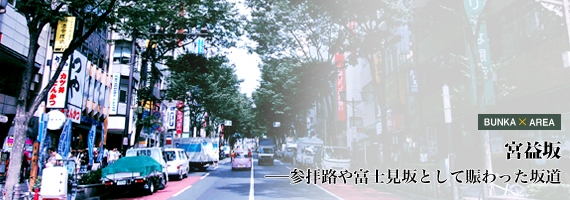
■ HeadingThe Edo period was crowded with people who enjoy the view of Mount Fuji "Fujimi slope"
- Urban development advances that incorporate the calm of Aoyama
And publishing company Art continue to transmit the culture to the axis
- An art store, antiquarian bookshop .... Long-established is dotted tickle the intellectual curiosity
Click to area information ※ will be displayed
Miya Miyamasuzaka the contemporary dining options and long-established shops are mixed, but the area where the old and new culture is well-balanced fusion. Old has developed as a highway muscle of Oyama Road, once the temple was also known as slope Fujimi Miyamasuzaka. Covered with Zelkova trees, look back at the history of this hill full of tasteful calm.

Once the house was called the hill Fujimi Miyamasuzaka
Across the Meiji street out to the east exit of JR Shibuya Station, appear entrance followed a gentle gradient Miya Miyamasuzaka. Namiki of zelkova is Soyogi in the wind, the slope of this about 450 meters was paved with cobblestones are there in the city, which was cluttered called Shibuya, drifted somewhere laid-back elegance. People out in the street as well, compared to other areas, slightly, but high impression age.
This area, in 1700 has been recorded to have been named Miyaeki town a year. Its origin, the theory is the leading that was Ayaka' to some in the middle of the hill utaki Gongen (current Mitake shrine).
Miya Miyamasuzaka is, as a starting point the Edo of Akasaka Mikado, was part of Oyama Road that leads to the ashigara pass. Oyama Road is, the middle of the Edo period and later, bustle as worship path to Oyama has been the object of mountain worship (located in Kanagawa Prefecture Isehara and Hadano), also to come and go as many worshipers in the temple Miyamasuzaka.

1953 around the temple Miyamasuzaka around
Source: Shirane Memorial Shibuya-ku, Provincial Museum, Museum of Literature
Further development since the end of the Edo period
But it is also difficult to imagine now, from the fact that I enjoyed the spectacular view of Mount Fuji through the four seasons from the temple Miyamasuzaka at that time, so it was called "Fujimi slope". MikiIku Kobayashi to serve as president of the Shibuya Miya gains shopping street promotion union, said, "travelers can stop the foot, it seems to have flourished and be such as teahouse from the fact that the dose by looking at the Mt. Fuji". Basho Matsuo admired the landscape, poem the phrase "when applied to the eye Ya especially Is the month Fuji". The monument is standing in the precincts of the current also Mitake shrine.
While so is the attractions, the temple Miyamasuzaka was steeper than the current, also known as a dangerous place of passage, the road paved stone, that had to slip to fill the bar of the log. Miya gains town show a further development since the end of the Edo period, in 1871 (Meiji 4) year "townspeople subsistence Book", in addition to a number of eateries, tub and umbrella, craftsmen and carpenters, such as lantern lived It is recorded with. The late Meiji period now through the temple Miyamasuzaka tram of the city of Tokyo-electrically, the streets are going to become more and more busy.

Mitake shrine of approach has become stepped
1923 after the Great Kanto Earthquake of the year, Miyaekimachi is renamed the "Shibuya on the street 2-chome", opposition movement occurs between the townspeople love the venerable place names since the Genroku era. But not accepted in public office, after the war ", Shibuya-ku, Shibuya 1-chome, 2-chome" in order to become, currently there is no place called Miya gains town. Still, locals continue to use the "Miya gains" as a common name, but now has been firmly established in visitors from outside.
It Miya Miyamasuzaka that flourished from the Edo period, but by the air raids of World War II, the cityscape was attributed to ashes. Among the residents proceed with the rebuilding work together, in the wake of the expansion of Aoyama Street along with the 1964 Tokyo Olympic Games of the year, also varies greatly streets of the temple Miyamasuzaka. "Although it up to the wooden two-story the merchant was a majority, Bill began to increase in one fell swoop," said Kobayashi recalls. It abolished streetcar from the increase in traffic volume in 1969. 1983 planted the zelkova with the completion of the sidewalk expansion project is a year, aesthetics was also complemented.
Miya developed rapidly progresses Miyamasuzaka under

Under Miya Miyamasuzaka intersection of travel of development
"We want to create an environment where adults can walk leisurely while taking in the calm atmosphere of Aoyama Street, at a distance from the noise of Shibuya symbolized by center town etc.," said Kobayashi's policy on town development Talk about In commercial development, the east exit has a sense of being led by the west exit, but in the future the development of the Tokyu Bunka Kaikan site and the establishment of Shin Shibuya Station with the opening of Tokyo Metro Co.,Ltd. FUKU-TOSHIN LINE in 2008 (2008) As a trigger, a rapid increase in the number of passers in the Miyamasuka area is also expected. How does Miya Masuzaka change in the flow and what leaves? I would like to pay attention to the future movement.

Overlooking the Sakagami than Miya Miyamasuzaka under
 |
Kobayashi MikiIku's 1940 birth. Serve as the Chairman of Shibuya Miya gains shopping street promotion association. Housed under the temple Miyamasuzaka from generations of grandparents, it has continued staring at the change of the land. |
【KEYPERSON】 窪田祐さん(ベイクルーズグループ代表)
【KEYPERSON】 大森秀樹さん(株式会社パワーショベル代表取締役)
"Miya Miyamasuzaka" peripheral Culture facility